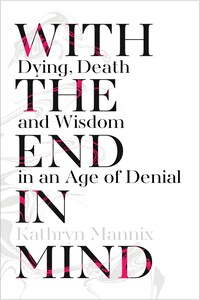William Collins
An imprint of HarperCollinsPublishers
1 London Bridge Street
London SE1 9GF
WilliamCollinsBooks.com
This eBook first published in Great Britain by William Collins in 2018
Copyright © Kathryn Mannix 2017
Kathryn Mannix asserts the moral right to be identified as the author of this work
A catalogue record for this book is available from the British Library
All rights reserved under International and Pan-American Copyright Conventions. By payment of the required fees, you have been granted the non-exclusive, non-transferable right to access and read the text of this e-book on-screen. No part of this text may be reproduced, transmitted, down-loaded, decompiled, reverse engineered, or stored in or introduced into any information storage and retrieval system, in any form or by any means, whether electronic or mechanical, now known or hereinafter invented, without the express written permission of HarperCollins.
Source ISBN: 9780008210885
Ebook Edition © January 2018 ISBN: 9780008210892
Version: 2017-12-30
In a life of stories, this book is dedicated with love to the tellers of tales:
to my parents, who gave me the words;
to my husband, who distils words into wisdom;
and to our children, whose stories are still unfolding.
It may seem odd that, after half a lifetime of keeping company with the dying, anyone should wish to spend even more time immersed in telling their stories. It may even seem presumptuous to offer those stories in the hope that readers will choose to accompany dying strangers across the pages. And yet that is what this book sets out to do.
Throughout my career in medicine, it has been clear to me that we bring our own ideas and expectations with us in any encounter with the Big Questions. Whether that is birth, death, love, loss or transformation, everyone frames their experience through the lens of what they already know. The trouble is, whereas birth, love and even bereavement are widely discussed, death itself has become increasingly taboo. Not knowing what to expect, people take their cues instead from vicarious experience: television, films, novels, social media and the news. These sensationalised yet simultaneously trivialised versions of dying and death have replaced what was once everyone’s common experience of observing the dying of people around them, of seeing death often enough to recognise its patterns, to become familiar with life lived well within the limits of decreasing vigour, and even to develop a familiarity with the sequences of the deathbed.
That rich wisdom was lost in the second half of the twentieth century. Better healthcare, new treatments like antibiotics, kidney dialysis and early chemotherapy, better nutrition, immunisation programmes and other developments radically changed people’s experiences of illness and offered hope of cure, or at least postponement of dying, that was previously impossible. This triggered a behaviour change that saw the sickest people being rushed into hospital for treatment instead of waiting at home to die. Life expectancies increased; many lives were enhanced and lengthened.
Yet these welcome healthcare advances can only remediate us up to a point; beyond the point of saving us to live ‘well enough’ there is a point of futility. Here, technology is deployed in a new deathbed ritual that is a triumph of denial over experience. The death rate remains 100 per cent, and the pattern of the final days, and the way we actually die, are unchanged. What is different is that we have lost the familiarity we once had with that process, and we have lost the vocabulary and etiquette that served us so well in past times, when death was acknowledged to be inevitable. Instead of dying in a dear and familiar room with people we love around us, we now die in ambulances and emergency rooms and intensive care units, our loved ones separated from us by the machinery of life preservation.
This is a book about real events. Everything described really happened to someone, sometime, in the last forty years. To preserve the anonymity of the people described, almost all the names have been changed, along with their jobs, and sometimes their gender or ethnicity. Because these are stories rather than case histories, sometimes the experience of several people is woven into a single individual’s narrative, to allow specific aspects of the journey to be depicted. Many of the situations may seem familiar because, despite our averted gaze, death is unavoidable, and these accounts will have parallels in many people’s own experience.














